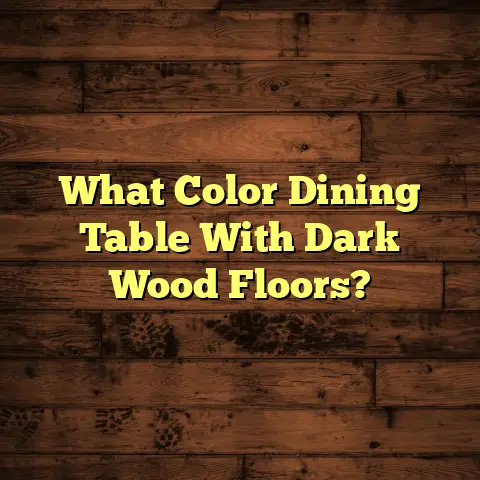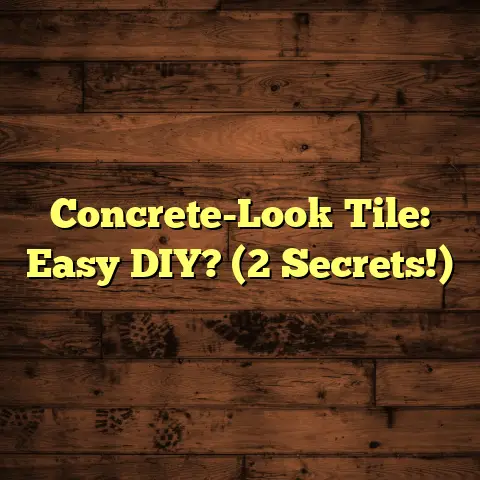Wood Floor Direction Fix? (9 Styles!)
Sometimes, it’s the wood floor direction. Seriously! It can make or break a space.
I’m going to walk you through the wonderful world of wood floor direction, showing you how it impacts everything from aesthetics to functionality.
We’ll dive deep into 9 different styles, giving you the knowledge to choose the perfect direction for your space.
Expert Tip: Light & Layout
“When installing wood flooring, always consider the natural light source and the layout of your space. Aligning the planks parallel to the longest wall or the main light source can create an illusion of a larger, more inviting area.”
That’s some gold right there!
It’s a launching point to explore wood flooring installation styles and how direction plays a pivotal role in each.
Section 1: Understanding Wood Floor Direction
So, what is wood floor direction?
It’s simply the way the planks are oriented when they’re installed. Sounds basic, right? But trust me, it’s anything but.
The direction can dramatically influence the overall vibe of a room. Think about it:
- Longer Room Illusion: Running planks lengthwise can make a narrow room feel longer.
- Wider Room Illusion: Running planks widthwise can make a narrow room feel wider.
- Directing the Eye: Direction can guide the eye to a focal point, like a fireplace or a stunning view.
We also need to talk about “flooring flow.” This is how your eye moves through the space, guided by the direction of the planks.
A good flow creates a sense of harmony and makes the space feel more accessible and inviting.
A poor flow can feel jarring and disjointed.
Section 2: The 9 Styles of Wood Floor Direction
Alright, let’s get into the nitty-gritty! Here are 9 different wood floor direction styles, each with its own unique aesthetic and practical considerations.
1. Straight Installation
Description
This is your classic, run-of-the-mill installation. Planks are laid parallel to each other, typically running the length or width of the room.
Aesthetic Appeal
It’s clean, simple, and versatile. This style works well with just about any interior design, from traditional to modern.
Pros and Cons
- Pros: Easiest installation, readily available materials, cost-effective.
- Cons: Can be a bit boring if not done right, might not add much visual interest.
2. Diagonal Installation
Description
Now we’re talking! Diagonal installation means laying the planks at a 45-degree angle to the walls.
Aesthetic Appeal
This creates a dynamic, visually interesting space. It can also make a small room feel larger.
Pros and Cons
- Pros: Illusion of larger space, adds visual interest, can hide imperfections in the subfloor.
- Cons: More complex installation, more waste material, can be overwhelming in a busy space.
3. Herringbone Pattern
Description
Ah, the herringbone – a true classic! This pattern features rectangular planks arranged in a staggered zigzag.
Aesthetic Appeal
It’s sophisticated, timeless, and adds a touch of elegance to any room. Think Parisian apartments and grand estates.
Pros and Cons
- Pros: Adds a touch of luxury, visually appealing, can increase property value.
- Cons: Intricate installation, requires a skilled installer, more expensive than straight installation.
4. Chevron Pattern
Description
Similar to herringbone, but with a key difference: the planks are cut at an angle to form a perfect “V” shape.
Aesthetic Appeal
Chevron is a bit more modern and streamlined than herringbone. It still has that classic feel, but with a contemporary twist.
Pros and Cons
- Pros: Modern take on a classic, visually striking, creates a sense of movement.
- Cons: Requires precise cuts and installation, can be costly, less forgiving than herringbone.
5. Plank Width Variation
Description
Instead of using planks that are all the same width, this style incorporates planks of varying widths.
Aesthetic Appeal
It adds a rustic, charming, and somewhat informal feel to the space.
Pros and Cons
- Pros: Adds visual interest, creates a unique look, can be used to highlight certain areas.
- Cons: Can look uneven if not done correctly, requires careful planning, can be difficult to source materials.
I’ve seen this done really well in farmhouse-style homes, where the varying widths complement the overall aesthetic.
6. Mixed Direction
Description
This involves combining different installation styles within the same space. For example, you might use a straight installation in the main living area and a diagonal installation in a hallway.
Aesthetic Appeal
It can create distinct zones within an open floor plan and add a lot of visual interest.
Pros and Cons
- Pros: Defines spaces, adds visual interest, can be customized to fit your needs.
- Cons: Complex planning and execution, requires a skilled installer, can look disjointed if not done well.
7. Random Width Installation
Description
Similar to plank width variation, but with a more organic and less structured approach. You’re essentially mixing different widths of planks in a seemingly random pattern.
Aesthetic Appeal
It creates a more natural, rustic, and less formal look.
Pros and Cons
- Pros: Adds character and uniqueness, creates a more organic feel, can be used to hide imperfections.
- Cons: Can be challenging to source materials, requires careful planning, might not appeal to everyone.
8. Basketweave Pattern
Description
This pattern involves arranging planks in alternating squares, creating a woven effect.
Aesthetic Appeal
It’s a visually striking and artistic choice that can serve as a focal point in a room.
Pros and Cons
- Pros: Unique and eye-catching, adds a touch of artistry, can increase property value.
- Cons: Complex installation, requires a skilled installer, can be overwhelming in a small space.
9. Curved Installation
Description
This is where things get really interesting! Curved installation involves bending and shaping the planks to create curves and flowing lines.
Aesthetic Appeal
It’s unconventional, modern, and avant-garde. This style is perfect for creating a truly unique and unforgettable space.
Pros and Cons
- Pros: Creates a one-of-a-kind look, adds a sense of movement and fluidity, can be used to soften harsh angles.
- Cons: Extremely challenging installation, requires specialized skills and tools, very expensive.
Section 3: Practical Applications of Wood Floor Direction Styles
Now, let’s talk about where these styles work best. Here’s a quick rundown:
- Straight Installation: Living rooms, bedrooms, hallways – it’s a safe bet for just about any space.
- Diagonal Installation: Small rooms, hallways, entryways – anywhere you want to create the illusion of more space.
- Herringbone Pattern: Living rooms, dining rooms, entryways – perfect for adding a touch of elegance.
- Chevron Pattern: Kitchens, bathrooms, modern living spaces – a stylish and contemporary choice.
- Plank Width Variation: Farmhouse-style homes, rustic interiors, kitchens – adds a touch of charm.
- Mixed Direction: Open floor plans, large living spaces – ideal for defining different zones.
- Random Width Installation: Rustic interiors, cabins, informal spaces – creates a relaxed and natural feel.
- Basketweave Pattern: Entryways, dining rooms, accent areas – use it to create a focal point.
- Curved Installation: Modern homes, art galleries, unique spaces – for those who want to make a statement.
Let me give you a few real-world examples:
- Living Room: I once installed a diagonal wood floor in a small living room, and it instantly made the space feel larger and more inviting.
- Kitchen: I recently installed a chevron pattern in a modern kitchen, and it completely transformed the space.
- Entryway: A basketweave pattern in an entryway is a surefire way to make a lasting impression on guests.
Conclusion
Choosing the right wood floor direction can feel overwhelming, but it’s worth the effort.
By understanding these 9 styles, you’ll be empowered to make informed decisions that enhance your interior environment.
Whether you’re going for a classic, modern, or completely unique look, the direction of your wood floors can make all the difference.
So, go forth and create the space of your dreams! You got this!





